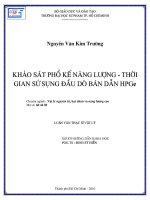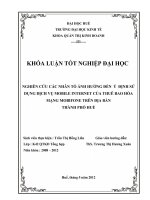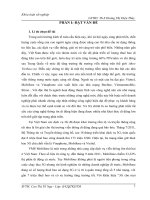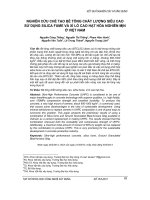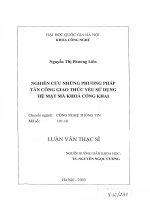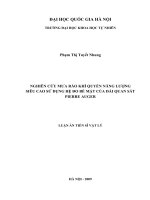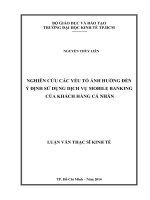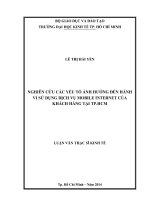Nghiên cứu mưa rào khí quyển năng lượng siêu cao sử dụng hệ đo bề mặt của đài quan sát piere auger
Bạn đang xem bản rút gọn của tài liệu. Xem và tải ngay bản đầy đủ của tài liệu tại đây (18.31 MB, 153 trang )
ĐẠI HỌC QUỐC GIA HÀ NỘI
TRƯỜNG ĐẠI HỌC KHOA HỌC TỰ NHIÊN
Phạm Thị Tuyế t Nhung
NGHIÊN CỨU MƯA RÀO KHÍ QUYỂN NĂNG LƯỢNG
SIÊU CAO SỬ DỤNG HỆ ĐO BỀ MẶT CỦA ĐÀI QUAN SÁT
PIERRE AUGER
LUẬN ÁN TIẾN SĨ VẬT LÝ
HÀ NỘI - 2009
ĐẠI HỌC QUỐC GIA HÀ NỘI
TRƯỜNG ĐẠI HỌC KHOA HỌC TỰ NHIÊN
Phạm Thị Tuyế t Nhung
NGHIÊN CỨU MƯA RÀO KHÍ QUYỂN NĂNG LƯỢNG
SIÊU CAO SỬ DỤNG HỆ ĐO BỀ MẶT CỦA ĐÀI QUAN SÁT
PIERRE AUGER
Chuyên ngành: Vật lý hạt nhân nguyên tử
Mã số : 62.44.05.01
LUẬN ÁN TIẾN SĨ VẬT LÝ
Người hướng dẫn khoa học:
1. DARRIULAT Pierre, Viện Khoa học Kỹ thuật Hạt nhân, Hà Nội
2. BILLOIR Pierre, LPNHE, Đại học Paris VI-UPMC
HÀ NỘI - 2009
ii
UNIVERSITE PARIS VI – PIERRE ET MARIE CURIE
ECOLE DOCTORALE DE PHYSIQUE
La Physique de la particule à la matière condensée (ED389)
Doctorat de Physique
PHAM Thi Tuyet Nhung
Contribution à l’étude des grandes gerbes à l’aide du
détecteur de surface de l’Observatoire Pierre Auger
Thèse dirigée par
BILLOIR Pierre, LPNHE, Université Paris VI-UPMC
et
DARRIULAT Pierre, Institut des Sciences et Technologies Nucléaires, Hanoi
Soutenue le 18 décembre 2009
Soutenue devant la commission d'examen composée de:
TRAN Minh Tam Président
De KERRET Hervé Rappoteur
NGUYEN Mau Chung Rappoteur
BILLOIR Pierre Directeur de thèse
URBAN Marcel
iii
ĐẠI HỌC QUỐC GIA HÀ NỘI
TRƯỜNG ĐẠI HỌC KHOA HỌC TỰ NHIÊN
PHAM Thi Tuyet Nhung
Nghiên cứu mưa rào khí quyển năng lượng siêu cao sử dụng
hệ đo bề mặt của Đài quan sát Pierre Auger
Người hướng dẫn khoa học:
DARRIULAT Pierre, Viện Khoa học Kỹ thuật Hạt nhân Hà Nội
và
BILLOIR Pierre, LPNHE, Đại học Paris VI-UPMC
Ngày bả o vệ luận án: 18/12/2009
Hội đồng chấm luận án:
TRAN Minh Tam Chủ tịch
De KERRET Hervé Phản biện
NGUYEN Mau Chung Phản biệ n
BILLOIR Pierre Người hướng dẫn
URBAN Marcel
iv
This thesis has been made under joint supervision of Professors Pierre
Billoir (LPNHE, Paris) and Pierre Darriulat (INST, Hanoi) following the
cooperation agreement on jointly supervision PhD. between the Université
Pierre et Marie Curie and the Hanoi University of Science.
Cette thèse a été réalisée sous la direction conjointe des professeurs
Pierre Billoir (LPNHE, Paris) et Pierre Darriulat (INST, Hanoi) en
application de la convention de thèse en cotutelle entre l’Université Pierre
et Marie Curie et l’Univesité Scientifique de Hanoi.
Luận án này được thực hiện dướ i sự đồng hướng dẫn của GS Pierre
Billoir (LPNHE, Paris) và GS Pierre Darriulat (INST, Hà Nội) theo văn bản
hợp tác đồng hướng dẫn nghiên cứu sinh giữa trường Đạ i học Pierre và
Marie Curie với trường Đại học Khoa học Tự nhiên Hà Nội.
v
Acknowledgement
This thesis was made under joint supervision by Pr Pierre Billoir and Pr Pierre Darriulat,
both of whom I express my deepest gratitude for their constant support and invaluable
guidance. In particular, I am very grateful to Pr Pierre Billoir for having made my stays in
Paris both efficient and enjoyable and for his kindness and patience in giving me
suggestions, explanations and advice. I also express my deepest gratitude to Pr Pierre
Darriulat, for his invaluable guidance and his enthusiasm that makes his students like
science and motivates them to pursue research.
I thank my colleagues in the Pierre Auger Collaboration for their understanding and
constant support, in particular the members of the Auger groups in LPNHE, IPN/Orsay and
LAL.
I acknowledge the help and support of my professors in Hanoi University of Science, in
particular Pr Nguyen Mau Chung, Pr Pham Quoc Hung, Pr Dao Tien Khoa and Pr Bui Duy
Cam. Warm thanks are also expressed to my colleagues in the Institute for Nuclear Science
and Technology for their help and encouragement.
I warmly thank the members of the VATLY group for their friendly help, discussion
(fruitful or not) and kind friendship that makes the life in the lab so pleasant.
I also express my deepest gratitude to my family for their patience and moral support.
Finally, I acknowledge financial support from World Laboratory, French Ministère des
Affaires Étrangères (bourse Évariste Galois), Rencontres du Vietnam (bourse Odon
Vallet), French CNRS, Vietnam Atomic Energy Commission and Vietnam Ministry of
Science and Technology.
vi
Résumé
Ce travail porte sur des observations réalisées à l’aide du détecteur de surface (SD)
de l’Observatoire Pierre Auger qui étudie les rayons cosmiques d’énergies supérieures à 10
EeV. Il détecte les grandes gerbes produites dans leur interaction avec l’atmosphère au
moyen d’un réseau de 1600 compteurs Cherenkov (CC) qui couvre 3000 km
2
. Les données
ont la forme d’un enregistrement digital des temps d’arrivée et des amplitudes des signaux
enregistrés par les trois photomultiplicateurs (PMT) de chaque CC. La thèse comporte des
études de leurs propriétés, d’une asymétrie observée entre les trois PMT d’un même CC et
de la désintégration de muons stoppant dans les CC.
En ce qui concerne la première, les incertitudes qui affectent la mesure ont été
évaluées et les différences observées entre les trois PMT d’un même CC ont été identifiées
et attribuées à deux causes bien maîtrisées : impulsions retardées et asymétrie de première
lumière. Un algorithme de recherche de pics, basé sur la déconvolution de la décroissance
exponentielle de la lumière détectée, a été affiné, sa performance évaluée et ses limites
identifiées, ouvrant ainsi la voie à son utilisation systématique dans des études ultérieures.
Une corrélation entre l’azimuth de la gerbe et l’asymétrie entre les trois PMT d’un
même CC, observée avant que la lumière n’ait le temps d’être suffisamment diffusée par
les parois, a été mise en évidence et exploitée pour mesurer la divergence de la gerbe et
illustrer la puissance de la méthode et sa sensibilité.
Enfin, on a mis en évidence l’existence de muons stoppant à l’intérieur du volume
des CC, identifiés par le signal produit par l’électron de désintégration. La difficulté de
cette étude réside dans la petitesse des signaux recherchés et permet de mettre à l’épreuve
la connaissance qu’on a du détecteur et des outils utilisés pour son analyse. Un bruit de
fond de très faible amplitude a été décelé, suggérant la présence vraisemblable de neutrons,
une possibilité qui reste à explorer.
vii
Tóm tắ t
Luận án trình bày nghiên cứu sử dụng số liệu của hệ đo bề mặt (SD), Đài quan sát
Pierre Auger. Đài quan sát này ghi nhận mưa rào khí quyển diện rộng sinh ra do tia vũ trụ
siêu năng lượng cao (trên 10 EeV) tương tác với bầu khí quyển. Hệ SD gồm 1600 bình đo
Cherenkov nước trải rộng trên diện tích 3000 km
2
. Với mỗi bình đo, thông tin về thời gian
và độ lớn tín hiệu được ghi nhận bởi ba ống nhân quang điện (PMT) và được lưu dưới
dạng số. Luận án tập trung nghiên cứu đặc điểm của bình đo Cherenkov, tính bất đối xứng
tín hiệu giữa các PMT vào thời điểm xuất hiện tín hiệu và phân rã của muon ở trong bình
đo.
Nghiên cứu đầu tiên đã đánh giá những yếu tố bất định ảnh hưởng tới phép đo và
đưa ra bằng chứng cho thấy sự không đồng nhất xảy ra ở một số thời điểm giữa các PMT
của một bình đo là do hiện tượng sau xung và sự bất đối xứng tín hiệu lúc bắt đầu được ghi
nhận. Hai hiệu tượng này đều có thể kiểm soát được. Nghiên cứu đã phát triển thuật toán
xác định đỉnh tín hiệu dựa trên việc loại bỏ phần suy giảm theo hàm mũ của ánh sáng ghi
nhận bởi các PMT đồng thời đánh giá về khả năng cũng như hạn chế của nó, tạo tiền đề
cho việc áp dụng phương pháp một cách hệ thống trong các nghiên cứu sâu hơn.
Bất đối xứng tín hiệu xảy ra trước khi ánh sáng phân tán đều do khuếch tán nhiều
lần trên thành bình. Nghiên cứu cho thấy hiện tượng này có tương quan với góc tới của
trục mưa rào khí quyển và có thể sử dụng để xác định độ phân kỳ của mưa rào, chứng tỏ
khả năng và minh họa cho độ nhạy của phương pháp.
Nghiên cứu phân rã muon trong bình đo dựa vào việc xác định tín hiệu của sản
phẩm phân rã là electron. Nghiên cứu này đã giải quyết một số khó khăn gây ra do biên độ
tín hiệu của electron rất nhỏ, cung cấp thêm một phép đánh giá khả năng hoạt động của
bình đo cũng như phương pháp phân tích tín hiệu. Nghiên cứu cũng cho thấy tồn tại một
phông nền thấp có thể gây ra bởi các neutron, điều này cần được làm rõ bằng các nghiên
cứu sâu hơn.
viii
Contribution to the study of ultra high energy showers
using the surface detector of the Pierre Auger Observatory
Summary
The present thesis deals with observations made using the surface detector (SD) of
the Pierre Auger Observatory that studies cosmic rays having energies in excess of 10
EeV. It detects the extensive air showers produced by such cosmic rays in their interactions
with the atmosphere in an array of 1600 water Cherenkov counters (CC) that covers 3000
km
2
. The information available from the SD is in the form of digitized records of the time
of arrival and amplitude of the signals recorded in each CC by three photomultiplier tubes
(PMT). The thesis includes studies of their properties, of the early time PMT asymmetry
and of the decay of muons stopping in the counters.
Concerning the former, the uncertainties affecting the measurement have been
evaluated and evidence has been given that the occasional apparent inconsistencies
between the three PMTs of a same CC reduce to only two types, after pulses and early time
asymmetries, both of which are under control. A peak finding algorithm consisting in
unfolding the exponential decay of the collected light has been refined, its performance has
been assessed and its limitations have been identified, opening the road toward its
systematic use in further studies.
A PMT asymmetry, occurring before the light has a chance of being randomized
by multiple diffusions on the CC walls, has been shown to be correlated with the azimuth
of the shower axis, which has been exploited to evaluate the shower divergence, to show
the power of the method and illustrate its sensitivity.
Finally, a search for muons stopping in the water volume of the CCs, identified by
the signal produced by the decay electron, has overcome the difficulties resulting from
their small amplitude and has given an opportunity to assess the detector performance,
providing a test of both the detector and the tools available for its analysis. Evidence has
been found for a very low charge background that might be associated with neutrons, a
possibility that remains to be explored.
ix
Mot-clé: rayons cosmiques d' énergies extrêmes
Từ khóa: tia vũ trụ năng lượng cao
Keyword: ultra high energy cosmic rays
x
Résumé substantiel en français
Les travaux présentés ici ont été réalisés dans le cadre de la Collaboration Pierre
Auger qui exploite l’Observatoire Pierre Auger (PAO) dans la pampa argentine et cherche
à répondre à un certain nombre de questions qui n’ont pas encore reçu de réponses
satisfaisantes concernant la nature et les propriétés des rayons cosmiques d'énergie
supérieure à 1 EeV, dits “d’ultra haute énergie” (UHECR). La construction de
l’observatoire a été menée à terme en juin 2008 mais la prise de données a commencé dès
janvier 2004 de telle sorte qu’une fois terminée la construction l’observatoire avait déjà
accumulé le plus grand ensemble au monde d’observations portant sur de tels rayons
cosmiques.
À l’époque où l’observatoire a été conçu, il était possible d’identifier un petit
nombre de questions fondamentales auxquelles il convenait de répondre en priorité ; elles
ont guidé les choix qui ont présidé à la conception de l’observatoire. Parmi elles on
comptait la dépendance en énergie du flux, et en particulier l’étude de l’interaction des
UHECRs avec le rayonnement fossile du fond cosmique (CMB) qui devait causer une
décroissance rapide du spectre aux plus hautes énergies (coupure GZK); la nature des
sources et le mécanisme d’accélération; la nature des UHECRs et, dans l’hypothèse
généralement admise qu’il s’agit de noyaux d’atomes ionisés, leur distribution massique.
Afin de répondre à ces questions, le PAO a été conçu comme un détecteur hybride
des grandes gerbes atmosphériques induites par les UHECR lorsqu’ils pénètrent dans
l’atmosphère terrestre. Il combine deux méthodes de détection très différentes qui se
complètent de bien des points de vue : un détecteur de fluorescence (FD) qui mesure le
profil longitudinal de la gerbe et un réseau au sol de compteurs Cherenkov à eau (SD) qui
mesure le profil transversal à partir de l’empreinte laissée par la gerbe au sol.
Aujourd’hui, le PAO a déjà répondu, pour l’essentiel, à la première de ces
questions et a mis en évidence l’effet de la coupure GZK. Au cours de la décennie
précédente, les astronomies en rayons X et gamma ont fait d’importants progrès dans
l’identification de restes de supernovae comme étant les sources des rayons cosmiques
galactiques (au dessous du domaine d’énergie des UHECRs) et dans la mise au clair du
mécanisme d’accélération. Toutefois, malgré les percées réalisées par le PAO dans le
domaine des autres questions, d’importantes incertitudes demeurent quant à la distribution
en masse des UHECRs et l’identification de leurs sources.
xi
La thèse ne s’adresse pas directement à ces questions mais contribue à améliorer
notre connaissance du détecteur de surface (SD) de sorte à faciliter et optimiser son
utilisation dans les recherches esquissées ci-dessus et, en particulier, dans les études
portant sur la distribution massique. Elle est structurée en quatre parties.
Une première partie sert d'introduction et survole l'état actuel de nos connaissances.
Un premier chapitre passe en revue les progrès récents de la physique des rayons
cosmiques en s'intéressant plus particulièrement aux questions pertinentes à l'étude des
UHECRs telles que les avancées récentes en astronomies X et gamma qui ont permis
d'identifier comme sources galactiques certains restes de supernovae (SNR) et comme
mécanisme d'accélération les passages répétés des particules d'aval en amont et d'amont en
aval du front de choc.
Un second chapitre sert d'introduction générale à l'Observatoire Pierre Auger en
insistant sur les caractères essentiels du détecteur de surface (SD) qui sont d'une
importance particulière pour les travaux présentés dans la thèse. On y trouve également un
résumé très bref des mesures de la dépendance du flux sur l'énergie et des progrès
accomplis dans l'identification de certaines sources à des galaxies de l'univers proche.
Un troisième chapitre est consacré aux problèmes posés par les mesures de
distribution massique qui sont en rapport étroit avec le sujet de la thèse. On y passe
rapidement en revue les méthodes utilisées, en particulier celles qui sont basées sur la
mesure de l'abondance relative des muons au sol (comparée à celle des électrons, positons
et photons), quantité censée permettre de distinguer entre primaires légers et primaires
lourds. La quatrième partie de la thèse présente une mesure de l'abondance des muons de
basse énergie (à l'arrêt dans le volume d'eau des compteurs Cherenkov où ils se
désintègrent). Ces muons de basse énergie sont minoritaires et ne sont pas censés dépendre
de la masse des primaires: leur étude permet de vérifier le bien-fondé des modèles
hadroniques et des simulations du détecteur dont on dispose indépendamment de la
distribution massique.
Une seconde partie étudie les propriétés générales de ce qui constitue la source
essentielle des données sur la quelle la thèse se base, les enregistrements appelés “traces
FADC”. Le réseau de détecteurs au sol du PAO est constitué de cuves d'eau dans
lesquelles les particules chargées relativistes de la gerbe produisent de la lumière
Cherenkov. Cette lumière est détectée par trois tubes photomultiplicateurs (PMT) de neuf
pouces dont les signaux sont enregistrés par des convertisseurs rapides analogue digital
xii
(FADC) dont la résolution en temps est de 25 ns et celle en charge de 0.5% du signal
produit par un muon relativiste d'incidence verticale. L'information que contiennent ces
traces est à la fois très riche et très difficile à décoder. L'apport essentiel de la thèse est de
contribuer à en faciliter l'interprétation et l'usage.
Un premier chapitre porte sur la fiabilité de l'information disponible, en particulier
sur la compatibilité des signaux enregistrés par les trois PMT d'un même compteur. L'étude
est abordée sans préjugé ni a priori quant aux causes de possibles incohérences et conclut
que les seuls désaccords existants, à l'exclusion de compteurs proches du cœur de la gerbe
où les PMT sont surchargés, ont deux causes bien connues: l'occurrence éventuelle de post
impulsions individuelles et une asymétrie de réponse entre les trois PMT, dépendant de
l'incidence des particules qui traversent le détecteur. Cette dernière cause est en rapport
étroit avec la matière de la troisième partie de la thèse. Les compteurs du SD constituent
d'excellentes cavités optiques et la lumière Cherenkov subit de nombreuses diffusions sur
leurs parois avant de s'échapper vers la photocathode d'un des trois PMT. Ces diffusions
ont pour effet de rapidement égaliser les réponses des trois PMT. Cependant, dans les
premiers quelque 30 ns, soit moins que deux bins, cette égalisation n'est pas complète (le
temps séparant deux diffusions successives est en moyenne de 10 ns) et le PMT qui se
trouve être le mieux exposé à la lumière Cherenkov enregistre un signal supérieur à celui
des deux autres.
Un second chapitre s'emploie à réduire les traces FADC en une somme de pics
associés à des particules individuelles. On y exploite l'excellente qualité optique des
compteurs qui permet de soustraire l'effet de la décroissance exponentielle de la lumière
détectée (produite presque instantanément mais diminuant avec un temps de relaxation de
l'ordre de 75 ns).
Une troisième partie concerne l'asymétrie dont on vient de parler, entre les trois
PMT d'un même compteur, et l'exploite pour étudier la divergence des gerbes. Elle débute
par une introduction à la méthode et aux calculs qu'elle implique et se poursuit en mettant
en évidence l'existence d'une forte corrélation entre l'asymétrie et la direction d'incidence
des particules sur le compteur. En combinant les informations associées à tous les
compteurs d'une même gerbe, on peut évaluer la divergence moyenne de la gerbe ou, ce
qui revient au même, l'altitude moyenne de la source le long de l'axe de la gerbe. La grande
quantité de données disponibles réduit considérablement les incertitudes statistiques et la
xiii
sensibilité de la méthode est illustrée par une étude de la dépendance de la divergence sur
divers paramètres caractéristiques des propriétés de la gerbe.
Une quatrième et dernière partie est consacrée à l'étude des muons de basse énergie
qui appartiennent aux grandes gerbes et sont ralentis et stoppés à l'intérieur des compteurs
où ils se désintègrent. Une telle étude implique la définition d'un ensemble de critères
permettant d'identifier et sélectionner des signaux associés aux électrons et positons
produit lors de la désintégration des muons. Ce sont des signaux de faible amplitude,
difficiles à bien mesurer. Une fois sélectionné un échantillon d'électrons candidats, un
certain nombre de sources possibles de bruit de fond sont identifiées et soustraites. Une
troisième étape consiste à mesurer le temps de vie des muons, ce qui implique de faire des
hypothèses sur la distribution des temps auxquels les muons mères se sont arrêtés.
Finalement, les résultats sont comparé aux prédictions de simulations. Bien qu'un accord
général soit le résultat dominant, un signal de bruit de fond de très faible amplitude, absent
des simulations, est mis en évidence, suggérant la présence d'une composante neutronique.
L'intérêt de cette étude réside dans le fait qu'elle exploite les qualités du détecteur jusqu'à
ses limites et permet de ce fait d'acquérir une confiance accrue en sa fiabilité.
La thèse se termine par un bref résumé et quelques considérations portant sur les
voies nouvelles qu'elle a permis d'ouvrir dans les directions qu'elle a explorées.
Contents
Preamble
1. Ultra high energy cosmic rays and the Pierre Auger Observatory 7!
1.1 Generalities on cosmic rays 7!
1.1.1 A brief history 7!
1.1.2 The main features 9!
1.1.3 Galactic sources 10!
1.1.4 Diffusive shock acceleration 12!
1.1.5 Extra galactic sources 14!
1.2 The Pierre Auger Observatory 17!
1.2.1 General description 17!
1.2.2 The surface detector 19!
1.2.3 Cherenkov tanks 22!
1.2.4 Simulations 24!
1.2.5 Energy spectrum and the GZK cut-off 25!
1.2.6 Correlations with astronomical sources 26!
1.3 Identification of the primaries 29!
1.3.1 General considerations 29!
1.3.2 Longitudinal profiles 30!
1.3.3 Risetime 31!
1.3.4 Muon abundance 34!
1.3.5 Summary 35!
2. FADC traces 37!
2.1 General features 37!
2.1.1 Noise 37!
2.1.2 Base-line 39!
2.1.3 Photoelectron statistics 43!
2.1.4 After-pulsing 47!
2.1.5 Spikes 52!
2.1.6 Summary 57!
2.2 Pattern recognition 59!
2.2.1 Introduction 59!
2.2.2 Preliminary data reduction and selection 60!
2.2.3 Subtraction algorithm 61!
2.2.4 Early time asymmetries 66!
2.2.5 Muons 69!
2.2.6 Adjacent signals 71!
2.2.7 Summary 73!
3. PMT asymmetries and shower divergences 74!
3.1 Introduction 74!
2
3.1.1 Motivation 74!
3.1.2 Arithmetics 74!
3.2 Overview of the method 77!
3.2.1 Azimuth-asymmetry correlation 77!
3.2.2 Shower divergence 80!
3.3 Intrinsic asymmetry 83!
3.3.1 Introduction 83!
3.3.2 Results 84!
3.4 Single vertex approximation 86!
3.4.1 Dependence on energy and zenith angle 86!
3.4.2 Dependence on other parameters 89!
3.5 Summary 93!
4. On the decay of muons stopping in the SD tanks 94!
4.1 General considerations 94!
4.1.1 Time range 94!
4.1.2 Muon energies 95!
4.1.3 Muon lifetime 95!
4.1.4 Electron signals 96!
4.1.5 Scope of the study and data sample 96!
4.1.6 Simulated data 98!
4.1.7 General outline 99!
4.2 Selection criteria 100!
4.2.1 Baseline correction 100!
4.2.2 After-pulses 101!
4.2.3 Charge cuts 102!
4.2.4 Trace-by-trace definition of the late region 105!
4.3 Background sources 110!
4.3.1 Simulated data 110!
4.3.2. Real data 116!
4.3.3. Systematic uncertainties 122!
4.3.4. Nucleon background 123!
4.4 Counting stopping muons 126!
4.4.1 Method 126!
4.4.2 Validation of the method 129!
4.5 Results 130!
4.6 Summary and conclusions 131!
5. Summary and perspectives 133!
References 135!
Acknowledgement
3
Preamble
The work presented here has been performed within the framework of the Pierre
Auger Collaboration that operates the Pierre Auger Observatory (PAO) in the Argentinean
pampas and aims at answering a number of open questions concerning the nature and
properties of cosmic rays having energies in excess of 1EeV, which are referred to as ultra
high energy cosmic rays (UHECR). The construction of the Observatory was completed in
June 2008 but it started taking data as soon as January 2004 and, by the time of
completion, had already accumulated the world's largest data set of cosmic ray
observations
At the time of conception, a few major questions could be singled out as having to
be addressed in priority and as governing the main options chosen for the design. These
included the energy dependence of the flux, and in particular the study of the interaction of
UHECRs with the cosmic microwave background (CMB), expected to cause a steep
decrease in the energy spectrum (referred to as GZK cut-off); the nature of the sources and
of the mechanism of acceleration; the nature of UHECRs and, under the generally accepted
hypothesis that they are ionized nuclei, their mass composition.
In order to answer such questions, the PAO was conceived as a hybrid detector of
the atmospheric showers induced by UHECRs penetrating in the Earth atmosphere. It
combines two very different methods of detection which complete each other in many
respects: a fluorescence detector (FD) measuring the shower longitudinal profile and a
ground array of water Cherenkov counters (SD) measuring the shower transverse profile
on ground.
Today, the PAO has essentially answered the first of the above questions and given
evidence in favour of the GZK cut-off. During the past decade, X-ray and gamma-ray
astronomy have made important progress at identifying sources of galactic cosmic rays
(below the UHECR energy range) and at elucidating the acceleration mechanism.
However, in spite of major progress achieved by the PAO toward answering the latter
questions, major uncertainties still remain today on the mass composition of UHECRs and
on the identification of their sources.
The present work does not address directly these questions but contributes to the
understanding of the performance of the surface detector (SD) in a way that should help
4
making optimal use of it, in particular in mass composition studies. It is organized in four
parts.
A first part introduces the subject by giving an overview of current knowledge. A
first chapter reviews in very broad terms the general status of present days cosmic ray
research with particular emphasis on topics of relevance to the study of UHECRs such as
recent progress in X-ray and gamma-ray astronomy, leading to the identification of Super
Nova Remnants (SNRs) as galactic sources and of diffusive shock acceleration as the
associated acceleration mechanism.
A second chapter gives a general introduction to the Pierre Auger Observatory,
with emphasis on the essential features of the SD, which are of particular relevance to the
present work. It also reviews very briefly the measurement of the energy spectrum, the
evidence for the GZK cut-off and the progress made toward identifying sources with
nearby galaxies.
A third chapter focuses on the problem of measuring the mass composition, which
is of more direct relevance to the present work. It reviews very briefly some of the methods
being used, in particular those which rely on the relative muon population on ground
(compared to electrons, positrons and photons), a quantity expected to be a discriminant
between light and heavy primaries. Part 4 of the present work studies low energy muons
(stopping and decaying within the volume of the SD water Cherenkov counters). Such low
energy muons are a minority and are not supposed to depend on the mass of the primary:
their study provides a check of both hadronic models and detector simulation independent
from the mass composition.
A second part studies the main features of the essential source of information on
which the present work is based, the so called FADC traces. The ground PAO array is
made of water Cherenkov counters detecting the Cherenkov light emitted by fast shower
charged particles crossing the water volume. The light is detected by three 9"
photomultiplier tubes (PMT), the signals of which are recorded by fast analog to digital
converters (FADC) with a bin size of 25 ns and a charge resolution of 0.5% of the signal
produced by a vertical relativistic muon. The information contained in such traces is both
extremely rich and extremely difficult to disentangle. The main contribution of the present
work is to progress toward being able of making better use of it.
5
A first chapter addresses the question of the reliability of the available information,
in particular by evaluating the consistency between the FADC traces of individual PMTs.
The problem is tackled without any a priori presumptions on the nature and the cause of
possible inconsistencies and concludes that, far enough from the shower core where PMTs
are overloaded, the only significant inconsistencies are due to two well known sources: the
occurrence of after pulses in individual PMTs and an asymmetry between the three PMT
responses depending upon the angle of incidence and impact of the detected particles. The
latter is of direct relevance to Part 3 of the present work. The Cherenkov SD tanks happen
to have excellent optical properties and the Cherenkov light makes many diffusions on the
tank walls before being absorbed or escaping in the photocathode of one of the PMTs.
Such diffusions randomize the light and equalize the PMT responses. However, in the first
30 or so ns, i.e. less than two FADC time bins, randomization is not yet complete (a typical
light path from wall to wall takes 10 ns) and the PMT that happens to be most efficiently
illuminated records a larger signal than the others.
A second chapter attempts at resolving the FADC traces as sums of individual
peaks associated with individual particles. It makes use of the already mentioned excellent
optical properties of the Cherenkov tanks which make it possible to unfold the exponential
decay of the detected light (produced almost instantaneously but decreasing with a
characteristic decay time of some 75 ns).
A third part studies the previously mentioned asymmetry between the three PMT of
a same tank and makes use of it to evaluate the shower divergence. It starts with an
introduction to the method and to the relevant arithmetics and goes on by providing
evidence in favour of a strong correlation between the direction of incidence of the
particles on a tank and the PMT asymmetry. Combining the information associated with all
tanks of a same shower makes it possible to evaluate its average divergence or,
equivalently, the average altitude of the source. The large size of the available data sample
allows for very small statistical errors and the sensitivity of the method is illustrated by a
study of the dependence of the location of the average altitude on parameters that
characterize the shower.
A fourth and last part studies low energy muons (part of a UHECR shower)
stopping and decaying in the SD Cherenkov tanks. Such a study implies a set of criteria
allowing for the selection of FADC signals associated with electron produced by the decay
6
of stopping muons. These are small signals, difficult to measure. Once such signals have
been selected as decay electron candidates, various sources of background are identified
and subtracted. In a third step, the decay time distribution is measured, implying an
educated guess of the time at which the parent muon had stopped. Finally the results are
compared with expectation. The interest of the study is in its pushing quite far the limits of
the detector performance and therefore, inasmuch as it succeeds, in its giving increased
confidence in its reliability.
The report closes with a brief summary and some considerations on possible
continuations along the roads open by the work reported here.
7
1. Ultra high energy cosmic rays and the Pierre Auger
Observatory
1.1 Generalities on cosmic rays
1.1.1 A brief history
At the end of the XIX
th
century, scientists were puzzled by the spontaneous
discharge of their electroscopes, suggesting that some kind of an ionizing radiation was
present on Earth. In 1909, Wulf took his electroscope on top of the Eiffel Tower,
suspecting Earth radioactivity − that had been recently discovered − to be the cause.
However, he noted that the discharge rate was not decreasing with altitude as fast as he had
expected, suggesting the presence of a downward component [1]. Between 1911 and 1913
the Austrian physicist Viktor Hess (Figure 1.1) performed balloon measurements reaching
up to five kilometres in altitude and established the existence of an “unknown penetrating
radiation coming from above and most probably of extraterrestrial origin” [2]. He shared
the 1936 Nobel Prize with Carl Anderson.
In the following years cosmic rays became the subject of intense research, in
particular with Millikan (who coined the name in 1925) and Anderson at Pikes Peak. In
1927 the measurement of the east-west asymmetry and of the dependence of the rate on
latitude established unambiguously that cosmic rays were charged particles, not photons
[3]. In 1938, Pierre Auger (Figure 1.1), using counters in coincidence, discovered
extensive air showers (EAS) and understood that they were produced by very high energy
(up to at least 10
15
eV) primaries interacting with the Earth atmosphere [4].
In the thirties and forties, when accelerators were not yet dominating the scene,
cosmic rays became the laboratory for the study of particle physics. Anderson (Figure 1.1)
discovered the positron [5] in 1932 and the muon [6] in 1936. Powell and Occhialini
discovered the pion [7] in 1947. Then came strange particles: kaons, hyperons and many
others. In the fifties, accelerators took over and cosmic rays got studied for their own sake.
For many years following, major effort was devoted to the study of cosmic rays,
trying to understand their origin [8]. Ground detectors, large arrays and fluorescence
8
telescopes, reached very high energies (John Linsley at Volcano Ranch saw the first
10
20
eV shower [9] in 1962). Space astronomy has been a break through for the study of
low energy cosmic rays, in particular solar energetic particles. A recent example of space
measurements in solar astronomy is the NASA's Advanced Composition Explorer which
was launched in 1997 to the Lagrange point between Sun and Earth.
In the past 20 years, spectacular progress in astrophysics and long time scales
implied in the construction of very high energy accelerators have caused a renaissance of
interest in cosmic rays physics under the name of astroparticle physics. In particular TeV
gamma ray detectors have been constructed and operated. Their main asset is that they can
point to the sources without suffering deflections from magnetic fields.
Figure 1.1 The pioneers: Viktor Hess and his balloon (upper panels), Pierre Auger at the
Jungfraujoch (lower left), and Anderson with his cloud chamber (lower right).
9
To study cosmic rays, a new generation of ground detectors was born. Plans to use
the whole Earth atmosphere as a radiator observed from space are being implemented and
neutrino astronomy is currently being pioneered.
1.1.2 The main features
Cosmic rays are ionized nuclei that travel in space up to extremely high energies of
the order of 10
20
eV=16 Joules! There are very few of them but their contribution to the
energy density of the Universe is similar to that of the CMB or of the visible light or of the
magnetic fields, namely ~1eV/cm
3
. Their power law energy spectrum (Figure 1.2),
spanning 32 decades (12 decades in energy), is of the approximate form E
–2.7
[10].
Whenever they have been measured, cosmic rays abundances are similar to
elemental abundances observed in their environment, suggesting that they have been
accelerated from interstellar matter. As in any galactic environment, hydrogen and helium
dominate, even-even nuclei are naturally favoured and the iron region, which corresponds
to the strongest nuclear binding, is enhanced. The main difference is that the valleys are
now filled by spallation reactions on the matter encountered by the cosmic ray during its
journey in the interstellar medium, ~7 gcm
–2
on average.
Figure 1.2. The cosmic ray energy spectrum displaying its main features.
10
While the very low energy part of the cosmic rays spectrum is of solar origin, most
of it does not reach the Earth, which is shielded by its magnetic field. The bulk of the
energy spectrum on Earth corresponds to an energy density of ~10
–12
erg/cm
3
. Most of it
must have a galactic origin because of the magnetic trapping in the Milky Way disk with a
galactic escape time of ~3 10
6
y. The cosmic rays power amounts therefore to some ~
10
–26
erg/cm
3
s which can be compared with the power delivered by SN explosions, ~10
–25
erg/cm
3
(~10
51
erg/SN and ~3 SN explosions per century in the disk). Namely cosmic rays
carry some 10% of the power delivered by SN explosions [8].
It is only in the higher energy part of the spectrum that an extra galactic component
can be found. Its energy density is estimated to some 2 10
–19
erg/cm
3
implying
a power of
~10
37
erg/Mpc
3
/s [8]. Both active galactic nuclei (AGN) and gamma ray bursts (GRB)
stand, from the point of view of energy, as possible sources.
1.1.3 Galactic sources
Particles coming from the Sun reach up to a few MeV and are mostly associated
with solar activity and flares. Coronal mass ejections and resulting interplanetary shocks
are similarly correlated. On the contrary, galactic cosmic rays are anticorrelated as solar
activity increases the Earth magnetic field, which acts as a shield.
Contrary to cosmic rays, gamma rays travel straight in the universe and point back
to their sources. They are good at detecting the high energy decay photons coming from
neutral pions produced in the interaction of very high energy cosmic rays with interstellar
matter. Gamma ray astronomy (Figure 1.3) has shown that several sources have an X ray
counterpart identified as an SNR (Figure 1.4) and has established this way that most
galactic cosmic rays are likely to originate from SNRs.
There exist two main types of SNRs: Ia and II. Type Ia occurs when a white dwarf,
member of a binary, accretes matter from its companion until it reaches Chandrasekhar
mass limit of 1.4 solar masses. The core is fully burned; the SNR shell is nearly empty.
Type II occurs when a massive star collapses into a neutron star that remains in the centre,
possibly detected as a pulsar, the wind of which gives energy to the remnant (one speaks of
a plerion).
11
Figure 1.3: The High Energy Stereoscopic System (HESS, Namibia) [11] includes four telescopes
at the corners of a 120×120 m
2
square, operating above 100 GeV. Its field of view is 5
o
and its
resolution a few arc minutes. To take a picture of the Crab takes only 30 seconds.
Figure 1.4. Very high resolution X ray images of SNRs (Chandra) [12].
From left to right: Cassopieia A, the Crab, Kepler (SN 1604), Tycho (SN 1572) and N49.
Figure 1.5 illustrates the correlation observed between high energy γ rays and X-
rays emitted by an SNR source [13], which establishes that they come from the shell. The
main features of SNR shell structures are reasonably well understood: the explosion blast
wave sweeps up the inter-stellar matter (ISM) in the forward shock. As mass is swept up,
the forward shock decelerates and ejecta catch up. Then, the reverse shock heats the ejecta
and nuclear reactions produce new heavy elements. Once enough mass has been swept up
the SNR enters the so-called Sedov phase and slowly dilutes in the ISM. While thermal
particles and magnetic field are concentrated in the shell, relativistic particles extend to
much larger distances and synchrotron emission is confined to magnetic field regions. The
shock structure depends on the SNR age.
